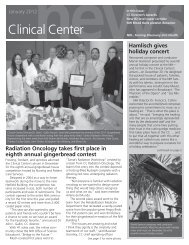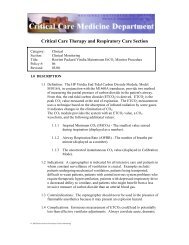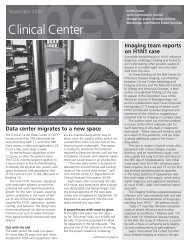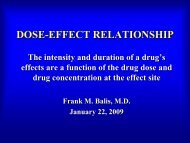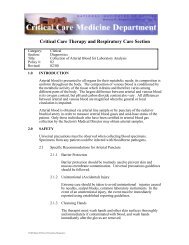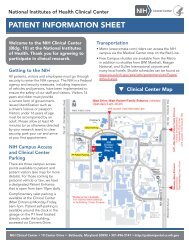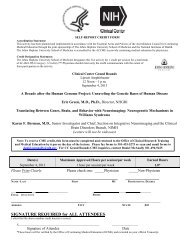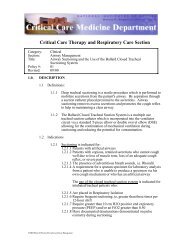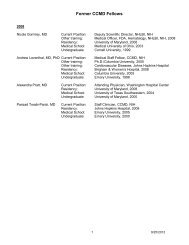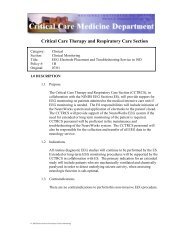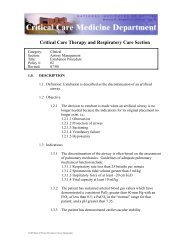2011 - NIH Clinical Center - National Institutes of Health
2011 - NIH Clinical Center - National Institutes of Health
2011 - NIH Clinical Center - National Institutes of Health
You also want an ePaper? Increase the reach of your titles
YUMPU automatically turns print PDFs into web optimized ePapers that Google loves.
ASTUTE CLINICIAN EXAMINES GENES’ ROLE IN LIVER AND HEART DISEASEThe 13th annual Astute Clinician Lecture broughta crowd to Masur Auditorium on November 17,2010, with a popular topic—“GenesVersus FastFoods: Eat, Drink & BeWary.”Dr. Helen H. Hobbs delivered the lecture establishedthrough a gift from the late Dr. RobertW. Millerand his wife Haruko.The Astute Clinician Lectureshiphonors a US scientist who has observed an unusualoccurrence and, by investigating it, has openedan important new avenue <strong>of</strong> research.Hobbs is a Howard Hughes Medical Institute investigator,director <strong>of</strong> the Eugene McDermott <strong>Center</strong>for Human Growth and Development, and pr<strong>of</strong>essor<strong>of</strong> internal medicine and molecular genetics at theUniversity <strong>of</strong>Texas Southwestern Medical <strong>Center</strong>.For the past 10 years she has spearheaded the DallasHeart Study, a large population-based study <strong>of</strong> DallasCounty.In her lecture—part <strong>of</strong> the <strong>NIH</strong> Director’sWednesdayAfternoon Lecture Series—Hobbs presentedthe case study <strong>of</strong> Morgan Spurlock, the star <strong>of</strong> thedocumentary “Supersize Me” that chronicled hisexperience with a McDonald’s-only diet. Spurlock’selevated liver function tests and cholesterol levelsafter only 12 days <strong>of</strong> his experiment is indicative<strong>of</strong> the effect such diet has on many Americans,albeit at a slower rate, Hobbs said.The elevated liver function tests are most likely dueto the development <strong>of</strong> fatty liver disease, which isassociated with both obesity and insulin resistance.However, some diabetics and obese people do nothave fatty liver disease, Hobbs said.“The question that we wanted to address was‘Are there genetic factors that are responsible forindividuals contributing to the propensity to deposittriglyceride in the liver?’” she said.Hobbs’ team also used genetics to examine therelationship between plasma levels <strong>of</strong> cholesterol andheart disease. Researchers know that high plasmalevels <strong>of</strong> cholesterol promote atherosclerosis (plaquebuildup in the arteries), Hobbs said. She presentedevidence that low plasma levels <strong>of</strong> cholesterol, ifmaintained over a lifetime, provide protection fromheart disease.Dr. Helen Hobbs <strong>of</strong> Universityit<strong>of</strong> Texas Southwestern Medical<strong>Center</strong> presented the 13thannual Astute Clinician Lecuture.With her is Dr. William Gahl,NHGRI clinical director.MEETING SUPPORTS ADVANCEMENT IN CRITICAL CARE TRIALS<strong>Clinical</strong> <strong>Center</strong> staff joined other <strong>NIH</strong> representativesand researchers from around the nation toencourage the best science and exchange ideas onclinical trials in critical care medicine in November2010.Approximately 100 researchers attended the thirdmeeting <strong>of</strong> the US Critical Illness and InjuryTrialsGroup, which vets study ideas, <strong>of</strong>fers networkingopportunities, and facilitates large, multi-center trials.This year’s meeting at Natcher Conference <strong>Center</strong>focused on neurologic emergencies.Attendees discussedthe key role played by emergency room andICU staff in treating strokes and other neurologicemergencies, when quick response matters most.“Meetings like this improve the efficiency <strong>of</strong> studies,”said Dr.Anthony Suffredini, associate chief <strong>of</strong> the CCCritical Care Medicine Department and member <strong>of</strong>the meeting organizing committee.“There was a lot<strong>of</strong> synergy between different groups in the multidisciplinarycritical care community who might nototherwise have the opportunity to communicate orcollaborate.”A N N U A L R E P O RT 2 0 1 1 • 2 1



